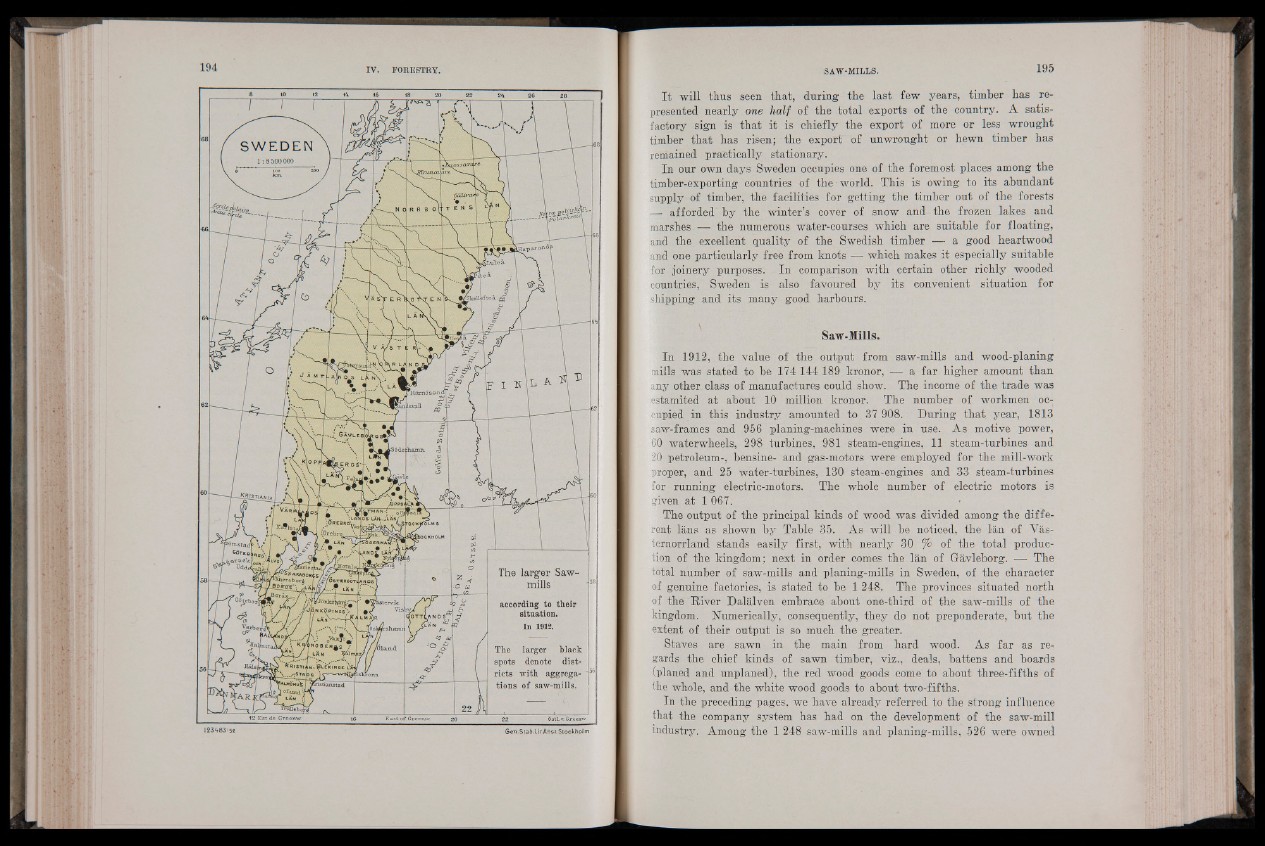
lOssaM
Gòtti*
lltcificius Vpôlar'
^.paxeu
• /S k e llU t «
H a rn o s a n i
Is vail
JigiSTlANi
jOREBRfl!^
tOrebro
»«»stadi
Gorea
©xack; 1 üddd Mxrtalj /¡Jv^®y*^VkA«RsbAoBriO RjI
lì£55£\^la| 'ÔSTCRCOTI
according to their
situation.
In 1912.
OT TUNO S
rshamn
inland The larger black
spots denote districts
with aggregations
of saw-mills.
lskrona
iau*ô'huS
LAN
itianstad
TraDebi
Gen. Stab. Li t.Anst. Stockhol m
It will thus seen that, during the last few years, timber has represented
nearly one half of the total exports of the country. A satisfactory
sign is that it is chiefly the export of more or less wrought
timber that has risen; the export of unwrought or hewn timber has
remained practically stationary.
In our own days Sweden occupies one of the foremost places among the
timber-exporting countries of the ■ world. This is owing to its abundant
supply-of timber, the facilities for getting the timber out of the forests
— afforded by the winter’s cover of snow and the frozen lakes and
marshes — the numerous water-courses which are suitable for floating,
and the excellent quality of the Swedish timber — a good heartwood
and one particularly free from knots — which makes it especially suitable
for joinery purposes. In comparison with certain other richly wooded
countries, Sweden is also favoured by its convenient situation for
shipping and its many good harbours.
Saw-Mills.
In 1912, the value of the output from saw-mills and wood-planing
mills was stated to be 174 144 189 kronor, -— a far higher amount than
any other class of manufactures could show. The income of the trade was
estamited at about 10 million kronor. The number of workmen occupied
in this industry amounted to 37 908. During that, year, 1813
saw-frames and 956 planing-machines 'were in use. As motive power,
60 waterwheels, 298 turbines, 981 steam-engines, 11 steam-turbines and
20 petroleum-, bensine- and gas-motors were employed for the mill-work
proper, and 25 water-turbines, 130 steam-engines and 33 steam-turbines
for running electric-motors. The whole number of electric motors is
given at 1 067.
The output of the principal kinds of wood was divided among the different
Ians as shown by Table 35. A s-w ill be noticed, the Ian of Vas-
ternorrland stands easily first, with nearly 30 % of the total production
of the kingdom; next in order comes the lan of Gavleborg. — The
total number of saw-mills and planing-mills in Sweden, of the character
of genuine factories, is stated to be 1 248. The provinces situated north
of the River Dalalven embrace about one-third of the saw-mills of the
kingdom. Numerically, consequently, they do not preponderate, but the
extent of their output is so much the greater.
Staves are sawn in the main from hard wood. As far as regards
the chief kinds of sawn timber, viz., deals, battens and boards
(planed and unplaned), the red wood goods come to about three-fifths of
the whole, and the white wood goods to about two-fifths.
In the preceding pages, we have already referred to the strong influence
that the company system has had on the development of the saw-mill
industry. Among the 1 248 saw-mills and planing-mills, 526 were owned